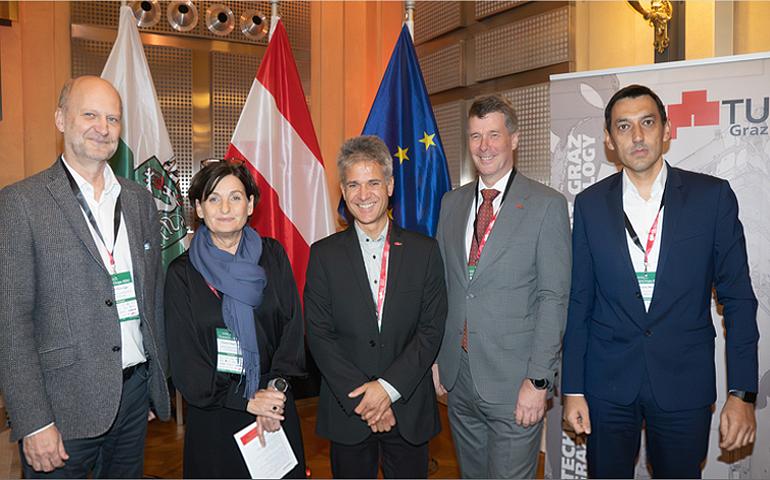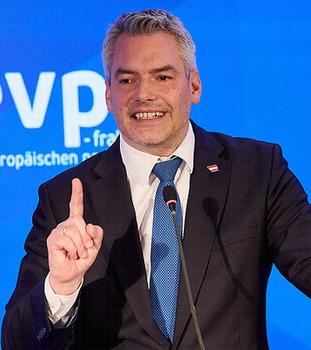EU Empowers Workers Today for Microchips of Tomorrow

By Sunny Lewis for Maximpact
GRAZ, Austria, October 31, 2023 (Maximpact.com Sustainability News) – A new international project led by the Graz University of Technology brings together 15 universities, companies and research institutions with the single goal of training urgently needed specialists for the European semiconductor industry, expected to boom now that the European Chips Act took effect in September.
The European Union is funding the project to the tune of €7.15 million, because semiconductor chips are strategic assets for key industrial value chains. With the ongoing digital transformation, new markets for the chip industry are emerging such as highly automated cars, the cloud, the Internet of Things, connectivity, space, defence and supercomputers, the European Commission explains in a statement.
There are the current markets for semiconductor chips – the essential building blocks of digital products we use constantly: smartphones and computers, appliances at home, lifesaving medical equipment, communications, energy, and industrial automation.
A survey conducted by the EU shows that, in 2020 a trillion microchips were produced worldwide – about 130 chips for every person on Earth. Despite this high production, in 2020 the world experienced a major chip shortage, leading to sharp increases in the prices of electronic goods.
In her 2021 State of the Union address, President of the European Commission Ursula von der Leyen said, “Our aim is to jointly create a state-of-the-art European chip ecosystem, including production. We need to link together our world-class research, design and testing capacities. We need to coordinate EU and national investment along the value chain. This is not just a matter of our competitiveness. This is also a matter of tech sovereignty.”
The circumstances were persuasive. On July 25, 2023, the EU Council approved the European Chips Act. Following approval by the Parliament, the regulation entered into force on September 21, 2023.
Austria’s conservative-Green government sees opportunities for building a modern chips industry with newly skilled workers.

“Austria should not only be known for Lippizaner, Mozartkugeln and clean electricity but also for microchips ‘Made in Austria’,” Chancellor Karl Nehammer said at a “chip summit” of industry representatives convened to enhance cooperation in the future. Chancellor Nehammer explained that the government wants to expand Austria’s role as “one of the leading European players.”
“This is a huge task. The industry itself will invest almost €7 billion in the next few years, and the federal government is committed to making its contribution in terms of framework conditions and subsidies,” Nehammer said.
Part of a larger campaign of digital innovation in Europe, the European Chips Act will facilitate an increase in chip production. The Act has clear-cut and ambitious goals for the next decade – to increase the EU’s global market share in chip production from 10 percent to 20 percent.
The European chips survey was launched in February 2022 with the aim of gathering preliminary information on current and future demand for chips and wafers, and as a first step to help understand the impact of the chip supply crisis on European industry.
Results of the survey were published in European Chips Report. <https://ec.europa.eu/newsroom/dae/redirection/document/89124>. In total, 141 responses were received and aggregated to provide a snapshot of insights and projections from the semiconductor value chain.
Over half of respondents were large enterprises, and just under half represented medium, small and micro-sized enterprises; 76 organisations had business activity on the supply side, 22 on the demand side, 16 were active on both the supply and demand side, businesses such as automotive original equipment manufacturers that produce finished cars and are also involved in semiconductor design, while the rest did not self-identify as either supply or demand.
The industries represented in the survey include: the electronics, mobility, digital, health, renewable energy, energy intensive, chemicals, construction, defence, aeronautics, agri-food, retail, proximity/social economy/civil security, cultural and creative sectors.
The survey found that demand for semiconductor chips is expected to double between 2022 and 2030, with increases in future demand for leading-edge semiconductor technologies. The supply crisis affects all economic sectors and is expected to last until at least 2024, forcing companies to adopt costly mitigating measures.
Companies establishing new chip fabrication facilities cite qualified labour and government regulations as key when selecting manufacturing locations
To resolve these issues, the Chips Act proposes:
• Investments in next-generation technologies
• Access across Europe to design tools and pilot lines for the prototyping, testing and experimentation of cutting-edge chips
• Certification procedures for energy-efficient and trusted chips to guarantee quality and security for critical applications
• A more investor-friendly framework for establishing manufacturing facilities in Europe
• Support for innovative start-ups, scale-ups and SMEs in accessing equity finance
• Fostering skills, talent and innovation in microelectronics
• Tools for anticipating and responding to semiconductor shortages and crises to ensure security of supply
• Building semiconductor international partnerships with like-minded countries
These measures are intended to raise the European microchip industry to a new level, with billions of euros being invested in the construction of new semiconductor production facilities. Germany will see the largest increase in construction with several new build and expansion projects. Other countries, too, such as France, Poland, Spain, and Italy, will see chips projects in the 2023-2024 timeframe.
The European Commission explains that the Chips Act should result in additional public and private investments of more than €15 billion. These investments will complement existing programs and actions in research and innovation in semiconductors such as Horizon Europe and the Digital Europe program, and announced support by EU Member States.
“In total, more than €43 billion of policy-driven investment will support the Chips Act until 2030, which will be broadly matched by long-term private investment,” the Commission projects in a Factsheet.
Building the Workforce in European Schools
For the operation of these new high-tech facilities, a large number of engineers and technicians are needed, and the Commission says that “so far it is unclear where they will come from.”

The electronics sector already lacks qualified personnel. In Austria alone, 14,000 additional skilled workers are needed, and Europe-wide estimates range from 60,000 to 150,000 more skilled workers needed than are currently available.
In order to counteract this shortage of skilled workers, seven European universities have joined forces with eight partners from industry and research in the “GreenChips-EDU” project. Together they want to accelerate the training of skilled workers in the field of microelectronics.
The European Commission is funding the four-year project with €7.15 million, and the Austrian Research Promotion Agency is adding another €750,000.
“In the past, production costs were the decisive factor for deciding on the location of production facilities in the microelectronics industry,” explains project manager Bernd Deutschmann, head of the Institute of Electronics at TU Graz. climate targets
“Today, microchips are developed and built where the skilled workers are. With GreenChips-EDU, European universities are joining forces for the first time to develop joint curricula for education in electrical engineering and microelectronics in order to train the necessary specialists in the best possible way,” Deutschmann said.
Of the seven universities, six are members of the “Unite!” network, the strategic alliance of nine universities of technology in Europe.
The focus of the university programs is on the development and production of sustainable and energy-efficient microchips, because power-saving microchips are indispensable to achieve the climate targets in Europe.
According to Deutschmann, the field of power electronics deserves special focus. “This is an area where Europe is an international leader and has great personnel needs for which we want to train young people,” he said.
The internationally harmonised university programs facilitate the cross-border recognition of academic achievements and promote student mobility, says Andrea Höglinger, vice rector for research at TU Graz.
On October 30, TU Graz kicked off the four-year GreenChips-EDU project with an event at the university featuring a networking lunch and talks by some of the officials involved in the project outlining details of the education and training planned to produce highly qualified professionals and students in micro-electronics. GreenChips-EDU is funded under the Digital Europe program, established in 2021.
The Digital Europe program supports projects in five key capacity areas: supercomputing, artificial intelligence, cybersecurity, advanced digital skills, and ensuring a wide use of digital technologies across the economy and society, including through Digital Innovation Hubs.
“GreenChips-EDU also shows the importance of international university networks. Graz University of Technology is part of the European University Alliance Unite!, as are several partners in the GreenChips-EDU project. A good network with excellent partners from science and industry is what makes a project like this possible in the first place,” says Höglinger.
“Our goal is for 600 students to complete a Bachelor’s or Master’s program during the four-year project period,” Deutschmann said. The Bachelor’s and Master’s programs are to be maintained after the end of the project period. In addition to the degree programs, GreenChips-EDU is developing further and higher education programs for industry professionals – ranging from short workshops to microcredentials and MBA programs.”
Companies Inspired to Cooperate
In addition to universities, an association and a research institute, six companies are involved in GreenChips-EDU, including Infineon Technologies Austria and Končar from Croatia. The industrial partners are involved, among other things, through teaching assignments and cooperation on Master’s theses.
Sabine Herlitschka, CEO of Infineon Technologies Austria, said, “Microelectronics is an enormous enabler to achieving the climate targets, thus contributing to decarbonization and digitalization. More than ever a skilled technical workforce is needed to implement these impactful innovations, to reduce carbon emissions and to leverage the enormous potential of energy efficiency.”
“These are highly attractive job opportunities capable to shape a better tomorrow. The new European “GreenChips-EDU” project will be instrumental in developing up-to-date and purpose-oriented curricula fit to attract more young people for technology studies,” Herlitschka predicted.
“As Infineon Austria, we contribute with our extensive expertise in research, development and manufacturing of energy-saving chips, as well as with our comprehensive educational activities for more than 100,000 young people over the last years,” she said.
“Together with this highly competitive consortium, we will generate enthusiasm for technology, boost education and empower technical specialists for the future,” Herlitschka exclaimed. “This is a very tangible initiative to strengthen Europe’s talent pipeline in this highly relevant field of microelectronics.”
Project members:
TU Graz, Austria
Politecnico di Torino, Italy
Technische Universität Darmstadt, Germany
Universitat Politècnica de Catalunya, Spain
Grenoble INP–UGA, France
Técnico Lisboa, Portugal
Carinthia University of Applied Sciences, Austria
INESC-ID Lisboa, Portugal
Infineon Technologies Austria AG, Austria
Končar Group, Croatia
Silicongate, Portugal
Akileo Formation, France
Aedvices, France
Business Konsens, Germany
R.U.S.Z Reparatur- und Service-Zentrum, Austria
Associated Project Partners include: Cadence, STMicroelectronics N.V., and The Stern Stewart Institute. Funders are the European Commission, and the Austrian Research Promotion Agency.